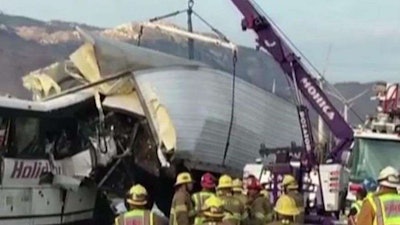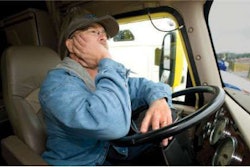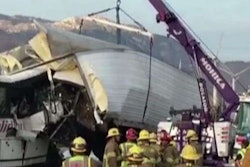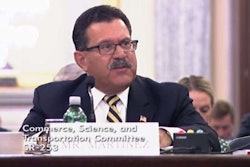
Authorities: Driver in deadly California bus crash didn't brake before hitting big rig https://t.co/FDrgOO860i pic.twitter.com/AkQoScyxHn
— Fox News (@FoxNews) October 25, 2016
The National Transportation Safety Board has determined the truck driver, bus driver and California DOT were at fault in an October 2016 crash in Palm Springs, Calif., involving a tractor-trailer and a tour bus that resulted in 13 deaths and 31 injuries. The Board also determined the trucker had untreated obstructive sleep apnea, and the bus driver had untreated diabetes and was fatigued, likely due to acute sleep loss, at the time of the crash.
NTSB issued this week a report detailing probable cause of the crash, which included safety recommendations to prevent similar crashes in the future.
NTSB’s conclusion comes just months after FMCSA nixed a rulemaking intended to set hard and fast sleep apnea screening criteria for U.S. truck operators. The apnea rule would have recommended truckers with a BMI of 33 or higher, and who met other qualifiers such as age, be referred for apnea testing. These drivers would then receive a temporary certification, pending the results of the test. The rule likely would also set return-to-service protocol and treatment requirements for drivers diagnosed with sleep apnea.
The truck-bus crash occurred on I-10 westbound on Oct. 23 when a bus carrying 42 passengers struck the back of a stopped 18-wheeler at highway speed. The 2015 International ProStar with 2012 Utility trailer, operated by Tri-State Collision LLC, had been stopped in a construction zone, but the driver did not begin moving again when the lane reopened. The impact killed the bus driver and 12 passengers and injured the truck driver and 30 bus passengers.
NTSB determined, based on evidence from the crash, the trucker didn’t move his truck because “he was most likely asleep at the time of the crash, due to fatigue that, given his extremely high level of obesity, probably resulted from undiagnosed and untreated moderate-to-severe obstructive sleep apnea.” The Board also determined the bus driver had sufficient time to take action to avoid the crash. However, the bus driver had untreated diabetes, NTSB says, even though he tested positive in a glucose urine test — meaning he likely had diabetes — during his most recent medical certificate examination.
“In this crash, not one but two commercial vehicle drivers – people who drive for a living – were unable to respond appropriately to cues that other motorists acted on,’’ said NTSB Chairman Robert L. Sumwalt. “Federal and state regulators, commercial motor carriers and professional drivers can do better. Given the stakes, they must do better.’’
“The minimal action the bus driver took to avoid the collision and the four hours or less of sleep he obtained in the day and a half before the crash indicate that he was fatigued at the time of the crash, most likely as a result of acute sleep loss,” NTSB states in its report.
NTSB also blamed the California Department of Transportation’s “inadequate transportation management plan” for the construction zone, which resulted in a hazardous traffic situation. Law enforcement on the scene “did not detect the combination vehicle’s lack of movement” when traffic was moving again, the report says.
At least 13 dead in California tour bus crash: https://t.co/1jY0dfOMJo pic.twitter.com/dK8g41NfXb
— Good Morning America (@GMA) October 24, 2016
Based on what it found to be probable cause, NTSB issued new safety recommendations to the Federal Motor Carrier Safety Administration; Tri-State Collision; the American Trucking Associations, Owner-Operator Independent Drivers Association and the Commercial Vehicle Safety Alliance, among others.
New recommendations to FMCSA include:
- Make its Medical Review Board’s recommendations on screening for obstructive sleep apnea formal guidance for medical examiners when evaluating drivers.
- Provide guidance for medical examiners on evaluating commercial drivers who are not known to have diabetes but have glucose in their urine.
The Board also reiterated previously-issued safety recommendations to FMCSA, including:
- Develop and disseminate guidance for commercial drivers, employers and physicians on the identification and treatment of obstructive sleep apnea.
- Require a full compliance review of new entrants that fail their safety audits, fail their corrective action plans or are issued expedited action letters.
Additionally, NTSB reiterated and reclassified a safety recommendation previously made to FMCSA to implement a program to identify commercial drivers at high risk for obstructive sleep apnea and require those drivers to provide evidence through the medical certification process of having been evaluated and treated, if necessary. The Board reclassified the recommendation as “Open – Unacceptable Response,” which means FMCSA either disagreed with NTSB’s recommendation, but the Board believes there is enough supporting evidence to ask the agency to reconsider its stance, or FMCSA did not take action on the recommendation in a timely manner.
Thirteen killed, 31 injured in California tour bus crash https://t.co/ooRBGf9spB pic.twitter.com/ak4A4vrGs3
— Reuters Top News (@Reuters) October 24, 2016
NTSB recommended to the trucker’s fleet, Tri-State Collision, to use data from all available driver monitoring systems to improve oversight of its drivers’ compliance with regulations.
Finally, to ATA, OOIDA and CVSA, the Board recommended the groups advise their members of the circumstances of this crash and encourage them to use driver monitoring system data for oversight of driver compliance with safety regulations.
NTSB also reiterated recommendations to the National Highway Traffic Safety Administration and truck and bus companies. It recommends NHTSA complete development of performance standards and protocols for assessing forward collision avoidance systems in commercial vehicles, and asks OEMs to install forward collision avoidance systems that include, at minimum, a warning component. Additionally, once NHTSA published performance standards for autonomous emergency braking, NTSB asks manufacturers to install these systems on all new vehicles.












